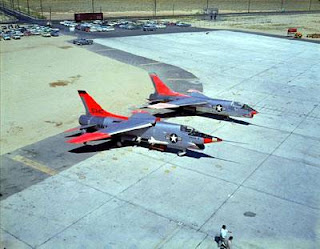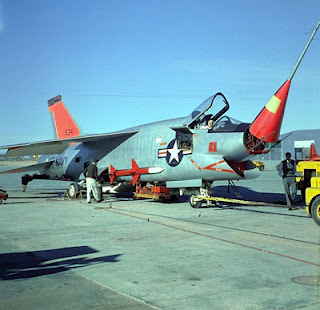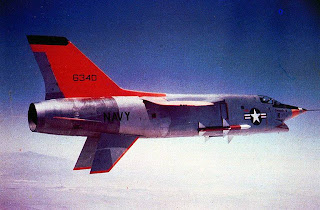Flightdeck Friday – XF8U-3 Crusader III
 Mach 2+ speeds with a fixed inlet. Push-button cruise control. All weather intercept capability with the AIM-7 Sparrow. A flat-out drag-racing king on the straights and in a climb. All this was the XF8U-3 Crusader III.
Mach 2+ speeds with a fixed inlet. Push-button cruise control. All weather intercept capability with the AIM-7 Sparrow. A flat-out drag-racing king on the straights and in a climb. All this was the XF8U-3 Crusader III.
< ?xml:namespace prefix = o />
XF8U-3 and F8U-1 (Vought photo)
Drawing on design work conducted on the Mach 2+ unmanned Regulus II cruise missile, Vought provided one of the signature recognition elements of the XF8U-3, the “sugar scoop†air inlet. For directional stability at the extreme altitudes it would be working at, large, folding ventral fins were added. Three semi-recessed AIM-7 semi-active radar homing missiles provided the main punch (and another distinctive feature – the nose wheel was offset to the right to make way for the Sparrow mounted under the fuselage) with four AIM-9 Sidewinders and four 20mm cannon, planned for production birds, completing the lethal load. The XF8U-3 tipped the scales at 24,928 lbs empty and grossed at 38,772 including 13,844 lbs of internal fuel. Pilot aids included an advanced flight control system and a “Mach Hold†button which enabled a constant speed and climb attitude to be easily maintained.
Regulus II (Vought photo)
First flight, after being shuttled to Edwards AFB in the bay of a C-124 Cargomaster, was 2 Jun 58. Right from the start the XF8U-3 showed its thoroughbred speed. Accelerating to take off speed the Crusader III was off the deck and outrunning the chase plane even before the gear was retracted. Nine days later the first supersonic run was made and the following month, Mach 2 was attained. Eventually a maximum speed of Mach 2.2 was regularly met. Design-wise, the Crusader III was assessed to be Mach 2.9 capable were it not for the limitation of the windscreen. Owing to the materials used, the windscreen was unable to withstand the heat of flight at Mach 2.9.
(Vought photo)
The first opportunity to decisively showcase its speed came with a “zoom-climb†that started at Mach 2 at 60,000 ft. pulling up, the Crusader III shot to over 75,000 ft (the engine suffered a compressor stall at 71,000 ft and it had to be dead-sticked to a landing when the pilot was unable to relight the engine). Compressor stalls would come to be one of the major problems for the Crusader III owing to the fixed inlet – over at McDonnell, the work they had accomplished on the F-101 (and later, the YF4H) led to their use of variable inlets that provided a means to control airflow into the inlet and thus, mitigate a tendency to compressor stalls experienced at operational speed and altitude.
(Vought photo)
Despite this tendency, the XF8U-3 was impressing those in charge. However, at the cusp of the 1960s, the Navy was faced with a multitude of diverse platforms and was looking for a way to consolidate missions and platforms. To this end it decided on a fly-off competition between Vought’s single-seat XF8U-3 interceptor and McDonnell’s YF4H-1 multi-role, two-seat fighter.
Notwithstanding demonstrated superior maneuverability and speed in some configurations than the YF4H, the XF8U-3 fell short in the multi-mission arena – and it so happened the Navy was headed in that direction with its principal tactical aircraft. More powerful radars and complex avionics/weapons systems demanded a second set of hands and eyes, dedicated to its operation and thus, a second cockpit for the Naval Flight Officer. The XF8U-3 could not accommodate either the multi-mission or the 2nd crewmember, and after seven short months, the fly-off was over and the McDonnell entry the declared winner.
Update! Courtesy reader Tommy Thomason, Vought *did* conduct a study with a 2nd seat (see below, also supplied by Tommy). Net result though was Vought hated the idea, feeling it added nothing in terms of capability and dcreased performance as supported by detailed analysis. He also notes that as the F4H vs. F8U-3 decision was being made, they (Vought) reportedly took a single seat interactive cockpit to Washington to demonstrate that one guy could handle the workload.

The Crusader III’s flying career was not over however. All three were assigned to NASA for developmental flight work (along with 2 unassembled airframes for spares). Unfortunately, after yeomanly service in NASA livery, all three airframes were scrapped and today, there are no survivors.
General characteristics
* Crew: 1 pilot
* Length: 58 ft 8 in (17.88 m)
* Wingspan: 39 ft 11 in (12.16 m)
* Height: 16 ft 4 in (4.98 m)
* Wing area: 450 ft² (41.8 m²)
* Empty weight: 21,860 lb (9,915 kg)
* Loaded weight: 32,320 lb (14,660 kg)
* Max takeoff weight: 38,770 lb (17,590 kg)
* Powerplant: 1× Pratt & Whitney J75-P-5A afterburning turbojet
o Dry thrust: 16,500 lbf (73.4 kN)
o Thrust with afterburner: 29,500 lbf (131.2 kN)
* Fuel capacity: 2,000 < ?xml:namespace prefix = st1 />
Performance
* Maximum speed: 2.9 Mach (estimated) at 50,000 ft (15,000 m)[1]
* Cruise speed: 500 knots (575 mph, 925 km/h)
* Range: 560 nm, (645 mi, 1,040) with external fuel
* Ferry range: 1,777 nm (2,045 mi, 3,290 km)
* Service ceiling: 60,000 ft (18,300 m)
* Rate of climb: 32,500 ft/min (165 m/s)
* Wing loading: 72 lb/ft² (350 kg/m²)
* Thrust/weight: 0.74
Armament
* Missiles:
o 3× AIM-7 Sparrow radar-guided missiles
o 4× AIM-9 Sidewinder missiles (planned for production)
Avionics
* Raytheon Aero 1B weapons control system, including:
* Autotechnicas AN/AWG-7 missile control system
* AN/APQ-50 radar (planned for production)
Don’t forget to checkout the Flightdeck Friday posting at the Tailhook Daily Briefing! This week’s topic – Part II of the Fabulous FORDs! (F4Ds)







I greatly enjoy your website and I have learned many new things about aircraft. However I feel that you have shortchanged the Super Crusader. The compressor stall problem was addressed and largely solved during 1958 before the so-called competition was over… The influence of Missouri Senator Symington was certainly a factor of great importance during the prolonged gestation of the Phantom. I hope to do research in this area and I would love to read the actual results of the Phase 1 evaluation.. Any idea how I might find it ? My research is butting up against search engines that have little info on the Super Crusader. Thanks again for all your writing and effort. Semper Fi to all you highly motivated Squids ! sincerely, Thomas Barton MOS 6467, MCAS Cherry Point, NC 1987-89.
Tom:
Thanks for your kind comments.
Re. further research on the XF8U-3, there are a couple of resources I’d hit first. For print media, there is the very excellent book by Tommy Thomason on the development of early jet fighters in the Navy titled: U.S. Naval Air Superiority: Delevelopment of Shipborne Jet Fighters – 1943-1962. The drawing you see above of the two seat variant was supplied by Tommy. You can also reach Tommy through his website, Tailspin Tales.
For deep-diving research-wse there is no better place to begin than the Naval Historical Center and its Naval Aviation History Branch. I’ve used their reesources several times and continue to be amazed at the wealth of info they have amassed, especially of an operational nature, and the courtesy and helpfulness of the staff.
Good luck with your research and drop a line if you need help.
– SJS
Tommy Thomason is working on a Naval Fighter series monography on the F8U-3. This should be the definitive word on this subject!
Tommy Thomason’s book on the Crusader III has been released and it is great. It is titled F8U-3 Crusader III (Naval Fighters series eighty seven) and the ISBNs are:
(ISBN-13) 978-0-986114-0-9
(ISBN-10) 0-9846114-0-1